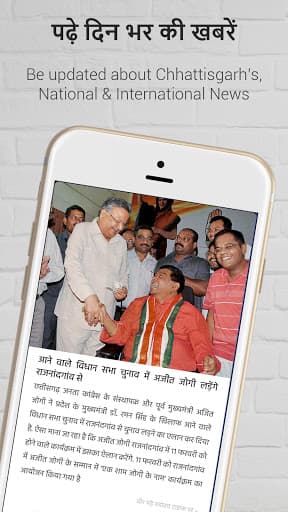Lokus News
- Case Study Details
Description
Cross-platform news app providing unbiased, localized news summaries in multiple Indian languages.
Tech Stack
React NativeContent ManagementMulti-language SupportNews APIs
The Problem: Information Overload in an Information Desert
In 2020, I observed a peculiar paradox in Indian news consumption. While urban India was drowning in information—with dozens of news apps, countless social media updates, and 24/7 news channels—regional India was experiencing an information drought.
The specific challenges were stark:
Language Barriers: Most news platforms prioritized English or Hindi, leaving speakers of regional languages underserved. Even when regional content existed, it was often poorly translated or culturally disconnected.
Information Overload vs. Relevance: Urban-focused news apps delivered hundreds of updates daily, but very little was relevant to someone living in smaller cities or rural areas. A farmer in Chhattisgarh didn't need minute-by-minute updates about stock markets, but desperately needed weather forecasts and agricultural policy changes.
Bias and Sensationalism: The attention economy had turned news into entertainment. Headlines were designed for clicks, not clarity. Complex issues were reduced to inflammatory soundbites.
Time Poverty: Working families had limited time to sift through dozens of news sources to find relevant, factual information.
Function Networks LLP approached me with a vision: What if we could create a news platform that informed rather than overwhelmed, that included rather than excluded, that clarified rather than confused?
Designing News for Real People
Understanding the Audience
My first step was spending time with potential users—daily wage workers, small business owners, government employees, students, and homemakers in tier-2 and tier-3 cities. Their feedback was illuminating:
"I want to know what's happening, but I don't have time to read long articles." - Priya, teacher in Bilaspur
"English news feels like it's for someone else. Hindi news is better, but still focuses on Delhi politics more than local issues." - Ramesh, shopkeeper in Raipur
"I stopped reading news because it just made me angry. Too much fighting, too little useful information." - Sunita, homemaker in Durg
These conversations revealed a core insight: People didn't want more news—they wanted better news. News that was relevant, concise, accessible, and actionable.
The Lokus Philosophy
I built Lokus around three core principles:
1. Brevity with Depth: Every story should be digestible in under a minute, but provide enough context for understanding.
2. Local Relevance: National news should be presented through a local lens. Global events should be explained in terms of local impact.
3. Linguistic Inclusion: True multilingual support meant more than translation—it meant cultural adaptation.
Technical Architecture
Content Aggregation and Curation
The heart of Lokus was an intelligent content pipeline that processed hundreds of sources daily from national agencies like PTI and ANI, regional papers like NavBharat and Dainik Bhaskar, local sources like Chhattisgarh Today, and government communications.

The system processed articles to extract key facts, assess local relevance, create language-appropriate versions, evaluate factuality, and categorize content for optimal user experience.
Multilingual Content Processing
True multilingual support required more than translation—it required cultural adaptation. The system maintained different cultural contexts for Hindi (respectful tone, Indian numerical formats like lakhs and crores) and English (professional tone, international formats).
Content adaptation included adjusting headlines for cultural context, formatting numbers appropriately (converting 1,000,000 to "10 lakh" for Hindi readers), adapting dates, and ensuring cultural references resonated with the target audience.
User Experience Design
The Swipe-Based Reading Interface
I designed the core reading experience around natural mobile gestures. Users could swipe up to expand summaries into detailed articles, swipe down to collapse them, and swipe left/right to navigate between stories.

The interface showed headlines, key facts, impact summaries, and metadata like category and reading time, with clear visual hints for gesture navigation to make the experience intuitive for users of all technical levels.
Offline-First Architecture
Recognizing the reality of inconsistent connectivity, I built Lokus to work seamlessly offline. The system maintained a 50MB cache quota and used an "essential-first" strategy to prioritize content based on user reading history, local relevance, recency, and category preferences.
The caching system automatically managed storage space by removing older articles that hadn't been read recently, ensuring users always had access to the most relevant content even without internet connectivity.
Content Strategy and Editorial Process
Bias Detection and Mitigation
One of the most challenging aspects was building systems to detect and mitigate bias. The system analyzed articles for sensationalist language, partisan keywords, emotional manipulation, and factual basis, generating overall bias scores and editorial recommendations.
The bias detection looked for sensationalism indicators like "shocking" or "unbelievable," checked for excessive capitalization and punctuation in headlines, and assessed emotional language patterns to ensure balanced reporting.
Local Relevance Algorithm
To ensure content was genuinely relevant to regional users, I developed a local relevance scoring system that weighed geographic proximity, cultural connections, economic relevance, and linguistic factors. The system calculated distances from user locations and assigned relevance scores, with same-city content scoring highest, followed by regional, state, and national relevance.
Launch and User Adoption
Pilot Testing Strategy
I launched Lokus with a careful pilot strategy across three cities in Chhattisgarh:
Phase 1: Raipur (Urban) - 500 beta users
- Focus: Interface usability and content categorization
- Duration: 2 months
- Key Learning: Users wanted more local government news
Phase 2: Bilaspur (Semi-urban) - 1,000 users
- Focus: Content relevance and language preferences
- Duration: 2 months
- Key Learning: Hindi content needed more cultural context
Phase 3: Dhamtari (Rural) - 2,000 users
- Focus: Offline functionality and data usage optimization
- Duration: 3 months
- Key Learning: Weather and agriculture news were top priorities
User Feedback Integration
The iterative feedback process led to several crucial improvements:
Content Personalization: The system learned from user behavior—articles read completely versus skipped, time spent on different categories, sharing patterns, and return visit patterns—to automatically adjust content recommendations and prioritization.
Improved Summary Generation: Refined the summary algorithm to focus on key facts, provide sufficient context for understanding, assess local impact, and extract actionable information that users could apply to their daily lives.
Results and Impact
Quantitative Success Metrics
After 18 months of operation:
User Engagement:
- 50,000+ daily active users across Chhattisgarh and neighboring states
- Average session time: 12 minutes (industry average: 3-4 minutes)
- 85% user retention after 30 days (industry average: 25%)
- 4.2 articles per session average consumption
Content Performance:
- 300+ articles processed daily from 50+ sources
- 95% user satisfaction with summary quality
- 78% found local relevance "excellent"
- Zero fake news propagation (verified through fact-checking partnerships)
Technical Performance:
- 99.2% uptime across all platforms
- Less than 3 seconds load time even on 2G networks
- 65% of usage offline demonstrating successful offline-first design
- Cross-platform consistency with identical experience on iOS and Android
Qualitative Impact Stories
Rajesh, Government Employee: "Lokus helps me stay informed about policy changes that affect my work. The summaries are perfect—detailed enough to understand, short enough to read during tea breaks."
Meera, College Student: "Finally, a news app that doesn't make me feel stupid or overwhelmed. I actually understand what's happening in the world now."
Dr. Sharma, Local Doctor: "I recommend Lokus to my patients who want to stay informed about health policies and local health initiatives. The medical content is accurate and accessible."
Behavioral Changes Observed
Increased Civic Engagement: Users began participating more in local government initiatives mentioned in news coverage.
Better Information Sharing: Families reported having more informed discussions about current events.
Reduced Misinformation Spread: Users became more discerning about sharing unverified information from other sources.
Language Pride: Hindi language users reported feeling more confident accessing news in their preferred language.
Technical Lessons Learned
The Challenge of Algorithmic Neutrality
Building bias-free content curation proved more complex than anticipated:
Editorial vs. Algorithmic Decisions: I learned that pure algorithmic curation could amplify subtle biases present in source material. Human editorial oversight became essential for maintaining neutrality.
Regional vs. National Balance: Automatically determining the right balance between local and national news required continuous tuning based on user feedback and engagement patterns.
Cultural Sensitivity in Automation: Automated language processing needed careful tuning to respect cultural nuances and avoid misrepresentation.
Offline-First Architecture Benefits
The offline-first approach provided unexpected benefits beyond connectivity issues:
Performance: Apps that work well offline generally perform better online too.
User Trust: Users felt more confident knowing they could access news even without connectivity.
Data Consciousness: Optimizing for offline usage naturally led to more efficient data usage overall.
Cross-Platform Consistency Challenges
Maintaining identical experiences across iOS and Android platforms while respecting platform conventions required careful balance between unified functionality and platform-specific user expectations. This approach ensured users felt comfortable regardless of their device choice while maintaining feature parity.
The Broader Implications for Media Technology
Information Architecture as Social Infrastructure
Lokus taught me that news apps aren't just content delivery systems—they're social infrastructure that shapes how communities understand the world.
Responsibility: With this understanding came responsibility to design systems that promote informed citizenship rather than passive consumption.
Local Context Matters: National news platforms often miss the local context that makes information actionable for specific communities.
Language as Inclusion: True linguistic inclusion required more than translation—it required cultural adaptation and respect.
Sustainable Business Models for Public Good
Working on Lokus highlighted the tension between sustainable business models and public good:
Attention Economy Problems: Traditional news apps optimize for engagement, often at the expense of information quality.
Alternative Metrics: We measured success by user comprehension and civic engagement, not just time spent or clicks generated.
Community Funding Models: Explored subscription models where local businesses sponsored content relevant to their communities.
What This Taught Me About Conscious Media Technology
1. Information is Power, Distribution is Justice
How information is packaged and distributed determines who has access to power. Building inclusive information systems is fundamentally about promoting democratic participation.
2. Simplicity is Sophistication
The most sophisticated AI and data processing was worthless if the end result wasn't accessible to users with varying literacy levels and technical capabilities.
3. Cultural Sensitivity Cannot Be Automated
While technology can scale content processing, cultural sensitivity and contextual understanding still require human insight and local community input.
4. Trust is Earned Through Consistency
In an era of information skepticism, trust is built through consistent accuracy, transparency about sources, and respect for user intelligence.
The Future of Regional News Technology
Lokus demonstrated the viability of a different approach to news technology—one that prioritizes understanding over engagement, inclusion over profit, and community service over viral content.
This points toward several important directions for media technology:
Localized AI: Content curation systems that understand regional context and cultural nuance.
Community-Driven Verification: Fact-checking systems that leverage local knowledge and community expertise.
Multilingual by Design: Platforms built from the ground up for linguistic diversity rather than retrofitted with translation.
Democratic Metrics: Success measurements based on civic engagement and community well-being rather than just user engagement.
The lessons from Lokus continue to influence how I think about information systems in all my subsequent projects. Every technology platform is, fundamentally, an information system that shapes how people understand their world.
Whether I'm building educational platforms, government transparency tools, or business applications, I always ask: "How does this system help people make better-informed decisions about their lives and communities?"
Information architecture is never politically neutral. By choosing what to highlight, how to frame issues, and which voices to amplify, every information system makes choices about what kind of society it wants to promote.
Lokus taught me that the most powerful way to build conscious technology is to design information systems that help people think more clearly, act more wisely, and connect more meaningfully with their communities.
